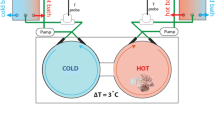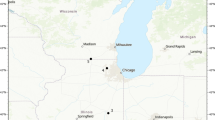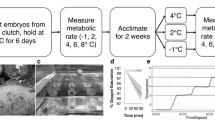Abstract
Acclimation temperature influenced the acute preferred temperature of the crayfishOrconectes obscurus. This species preferred a higher temperature than its acclimation temperature for those acclimation temperatures ranging from 6° to 26°C. When acclimated to 30° and 33°C, the crayfish preferred a lower temperature than its acclimation temperature. The final temperature preferendum is estimated to be approximately 30°C.
Similar content being viewed by others
References
Atwood, H. I. and Wiersma, C. A. G: Command interneurons in the crayfish central nervous system. J. Exp. Biology46, 249 (1967).
Becker, C. D., and R. G. Genoway: Resistance of crayfish to acute thermal shock: Preliminary studies. In J. W. Gibbons and R. R. Sharitz (ed:) Thermal Ecology NTIS Conf. 73 05051, p. 146, Springfield, VA (1974). Technical Information Center, Office of Information Services, U.S. Atomic Energy Commission, Washington, D.C.
Becker, C. D., R. G. Genoway, and J. A. Merrill: Resistance of a northwestern Crayfish,Pacifastacus leniusculus (Dana), to elevated temperatures. Trans. Am. Fish. Soc.104 (2), 374 (1975).
Cincotta, D. A., R. F. Denocourt, and J. R. Stauffer: A study of macroinvertebrates and fishes above and below two sewage treatment plants in the Codorus Creek Drainage, York County, Pennsylvania, Proc. Pa. Acad. Sci.50, 59 (1976).
Coutant, C. C: Compilation of temperature preference data. J. Fish Res. Bd. Can.34, 739 (1977).
Crawshaw, L. I.: Temperature selection and activity in the crayfishOrconectes immunis. J. Comp. Physiol.95, 315 (1974).
Fast, A. W., and W. T. Momot: The effects of artificial aeration on the depth distribution of the crayfishOrconectes virilus (Hagen) in two Michigan lakes. Am. Midl. Nat.89, 89 (1973).
Fraenkel, G. S., and D. L. Gunn: The orientation of animals kineses taxes and compass reactions. 2 ed. p. 258. New York: Dover (1961).
Fry, F. E. J.: Effects of the environment on animal activity. Univ. Toronto Stud. Biol. Ser. 55 Publ. Ont. Fish Res. Lab68, 1 (1947).
Gift, J. J.: Application of temperature preference studies to environmental impact assessment. J. Fish. Res. Bd. Can.34, 746 (1977).
Kennedy, D., W. H. Evoy, and J. T. Hanawalt: Release of coordinated behavior in crayfish by single central neurons. Science143, 917 (1966).
Kerkut, G. A., and B. J. R. Taylor: The effect of temperature changes on the activity of poikilotherms. Behavior13, 259 (1958).
Krasne, F. B., and J. J. Wine: Extrinsic modulation of crayfish escape behavior. J. Exp. Biol.63, 433 (1975).
Mihursky, J. A., and V. S. Kennedy: “Water temperature criteria to protect aquatic life.” A symposium on water quality criteria to protect aquatic life. American Fisheries Society Special Publication No. 4, 20 Washington, D.C. (1967).
Meldrim, J. W., and J. J. Gift: Temperature preference avoidance and shock experiments with estuarine fish. Ichth. Assoc. Bull. 7. 75 pp (Middletown, Delaware) (1971).
Meredith, W. G., and F. J. Schwartz: The crayfishes of Maryland, Tidewater News 15, No. 1, Supplement No. 12 (1962).
Presser, C. L.: Action potentials in the nervous system of the crayfish. IV. Influence of temperature on nerve impulses arising “spontaneously” in the abdominal ganglia. J. Gen. Physiol.19, 65 (1936).
Reynolds, W. W.: Temperature as a proximate factor in orientation behavior. J. Fish. Res. Bd. Can.34, 734 (1977).
Richards, F. P., W. W. Reynolds, and R. W. McCauley: Temperature preference studies in environmental impact assessments: An overview with procedural recommendations. J. Fish. Res. Bd. Canada,34, (5), 728 (1977).
Spoor, W. A.: Loss and gain of heat—tolerance by the crayfish. Biol. Bull.108, (1), 77 (1955).
Stauffer, J. R., D. S. Cherry, K. L. Dickson, and J. Cairns, Jr.: Laboratory and field temperature preference and avoidance data of fish related to the establishment of standards. In S. B. Saila (ed.): Fisheries and Energy Production Lexington Books, p. 110. Lexington, Mass.: D. C. Heath (1975).
Stauffer, J. R., Jr., K. L. Dickson, J. Cairns, Jr., and D. S. Cherry: The potential and realized influences of temperature on the distribution of fishes in the New River, Glen Lyn, Virginia. Wildlife Monographs. Nov. 1976, No. 50 (1976).
Wiersma, C. A. G., and K. Ikeda: Interneurons commanding swimmeret movement in crayfishProcambarus clarkii. Comp. Biochem. and Physiol.12, 509 (1964).
Author information
Authors and Affiliations
Rights and permissions
About this article
Cite this article
Hall, L.W., Cincotta, D.A., Stauffer, J.R. et al. Temperature preference of the crayfishOrconectes obscurus . Arch. Environ. Contam. Toxicol. 7, 379–383 (1978). https://doi.org/10.1007/BF02332065
Received:
Accepted:
Issue Date:
DOI: https://doi.org/10.1007/BF02332065




